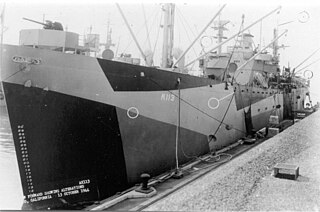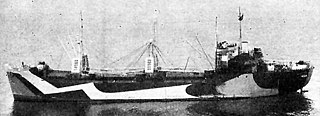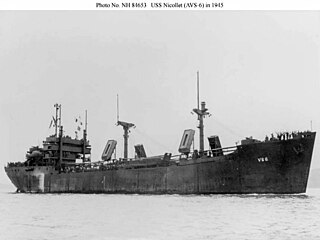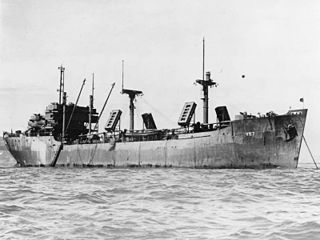USS Habersham (AK-186) was an Alamosa-class cargo ship that served the US Navy during the final months of World War II. She was named for Habersham County, Georgia.

USS Rutilicus (AK-113) was a Crater-class cargo ship commissioned by the US Navy for service in World War II. She was responsible for delivering troops, goods and equipment to locations in the Asiatic-Pacific Theater.

USS Alamosa (AK-156) was the lead ship of the Alamosa-class cargo ships, commissioned by the US Navy for service in World War II. She was responsible for delivering troops, goods and equipment to locations in the war zone.

USS Amador (AK-158) was an Alamosa-class cargo ship commissioned by the US Navy for service in World War II. She was responsible for delivering troops, goods and equipment to locations in the war zone.

USS Beaverhead (AK-161) was an Alamosa-class cargo ship commissioned by the U.S. Navy for service in World War II. She was responsible for delivering troops, goods and equipment to locations in the war zone.
USS Lebanon (AK-191) was a Alamosa-class cargo ship constructed for the US Navy during the end of World War II. However, as the war was ending, the need for additional cargo ships was found not necessary and Lebanon was sold for commercial service.

USS Nicollet (AK-199/AG-93/AVS-6) was an Alamosa-class cargo ship acquired by the U.S. Navy shortly before the end of World War II. She was converted into a Gwinnett-class aviation stores issue ship to carry aviation parts and spares, and to issue them to the US Pacific Fleet and activities as needed.

USS Pontotoc (AK-206/AG-94/AVS-7) was an Alamosa-class cargo ship acquired by the US Navy shortly before the end of World War II. She was converted into a Gwinnett-class aviation stores issue ship to carry aviation parts and spares, and to issue them to the US Pacific Fleet and activities as needed.
USS Fairfield (AK-178) was an Alamosa-class cargo ship acquired by the U.S. Navy during the final months of World War II. She served in the Pacific Ocean theatre of operations and was decommissioned shortly after war’s end.
USS Gadsden (AK-182) was an Alamosa-class cargo ship acquired by the U.S. Navy during the final months of World War II. She served the Pacific Ocean theatre of operations for a short period of time before being decommissioned and returned to the U.S. Maritime Administration.
USS Lancaster (AK-193) was an Alamosa-class cargo ship that was constructed by the US Navy during the closing period of World War II. She was declared excess-to-needs and returned to the US Maritime Commission shortly after commissioning.
USS Muscatine (AK-197) was an Alamosa-class cargo ship that was constructed for the US Navy under a US Maritime Commission contract during the closing period of World War II. She had a brief career before being decommissioned a year later.
USS Hidalgo (AK-189) was an Alamosa-class cargo ship that was constructed for the U.S. Navy during the closing period of World War II. She was declared excess-to-needs and returned to the U.S. Maritime Commission.

USS Pembina (AK-200) – later known as USNS Pembina (T-AK-200) -- was an Alamosa-class cargo ship that was constructed for the U.S. Navy during the closing period of World War II. She supported the end-of-war Navy effort and was subsequently placed in service with the US Army under the Shipping Control Authority for the Japanese Merchant Marine with a Japanese crew in Yokosuka, Japan.
USS Pemiscot (AK-201) was an Alamosa-class cargo ship that was constructed for the US Navy during the closing period of World War II. By the time she was scheduled for commissioning, the war's end caused her to be declared “excess to needs” and she was returned to the US Government and struck by the Navy.
USS Pipestone (AK-203) was an Alamosa-class cargo ship that was constructed for the US Navy during the closing period of World War II. By the time she was scheduled for commissioning, the war’s end caused her to be declared “excess to needs” and she was returned to the US Government and struck by the Navy.
USS Pitkin (AK-204) was an Alamosa-class cargo ship that was constructed for the US Navy during the closing period of World War II. By the time she was scheduled for commissioning, the war's end caused her to be declared “excess to needs” and she was returned to the US Government and struck by the Navy.
USS Rockdale (AK-208) was an Alamosa-class cargo ship that was constructed for the US Navy during the closing period of World War II. She served with distinction in the Pacific Ocean theatre of operations and returned home in 1946 to be placed into the "mothball" fleet and sold in 1947.
USS Schuyler (AK-209) was an Alamosa-class cargo ship that was constructed for the US Navy during the closing period of World War II. She served with distinction in the Pacific Ocean theatre of operations and returned home in 1946 to be placed into the reserve "mothball" fleet where she silently remained until she was scrapped in 1971.

USS Screven (AK-210) was an Alamosa-class cargo ship that was constructed for the US Navy during the closing period of World War II. She served in the Pacific Ocean theatre of operations and returned home in 1946 to be placed into the "mothball fleet" where she remained until sold in 1947 for commercial maritime service.
This page is based on this
Wikipedia article Text is available under the
CC BY-SA 4.0 license; additional terms may apply.
Images, videos and audio are available under their respective licenses.







